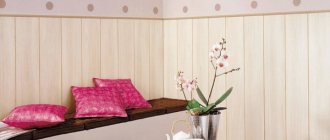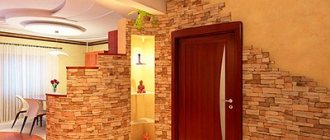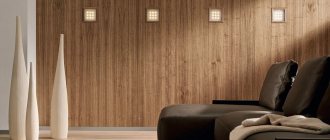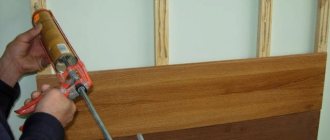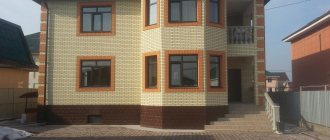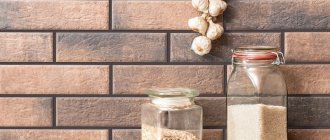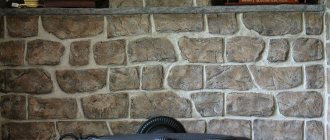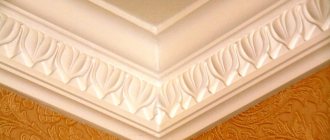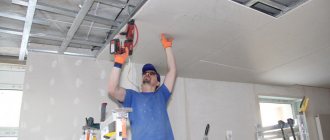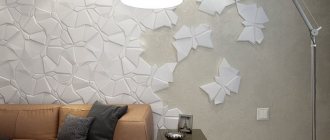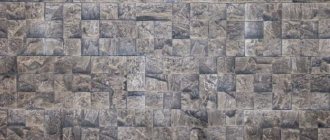Facade materials: prices
The building materials market offers a variety of brick-like wall panels for exterior decoration. Cost of some materials (Moscow region):
- Plastic facade panels. Wall and plinth parts measuring 0.39-0.45 m2 cost 220-550 rubles. (per piece, average price range).
- Fiber cement panels. The cost is affected by the material of the coating and filler. Panels with an acrylic protective layer cost from 1,700 rubles. per piece, with ceramics (Japanese) - from 3100 rub.
- Thermal panels. The cost is determined depending on the filler material and amounts to 1750-2400 rubles.
- Thermal panels with clinker tiles. The cost varies between 1250-2300 rubles/m2.
Examples of façade cladding with stone-look plastic panels
Cozy house covered with plastic panels to look like stone
Plastic panels are a very practical material
Here you can also finish the porch with plastic panels
Combination of natural stone and plastic panels
Pros and cons of stone siding
As a facing material, stone siding has many pros and cons.
Without touching on the specific properties of the material from which this or that panel is made, the following positive qualities can be highlighted:
- Many options for panel design, color or masonry texture.
- High precision simulation, full effect of a stone building.
- The smaller size of the panels makes installation easier and makes it possible to work alone.
- High quality of joining; there is no need for H-bars, which are necessary for the longitudinal connection of facade panels.
- Does not require maintenance (maximum: sometimes spray it with water from a hose to wash off the dust).
- The durability of the panels is comparable to the service life of the house itself.
The disadvantages of stone siding include:
- The large thickness of the panels creates an increased load on the walls.
- The strength of the cladding, while apparently indestructible, is still inferior to natural stone. Handle the cladding carefully, remembering that repairing or replacing one panel may require disassembling the entire façade.
The main and indisputable advantage of stone siding is the exquisite appearance of a finished house, the ability to create the appearance of an ancient or modern building using the same technology.
What is a base and why is it protected?
The basement part of the building is the lower, foot part of the walls, lying on the foundation . Often the basement part protrudes beyond the walls of the building. It happens that the base is located level with the wall line.
The basement of any building is the most vulnerable part in relation to dirt, mechanical stress, and moisture . A kind of transitional part from the foundation to the wall should prevent cold and water from entering the façade of the building, so it must be carefully protected and insulated.
A waterproofing barrier is used to protect against moisture. If there is a need to insulate the basement, install insulation. To prevent the influence of external factors, including mechanical stress, the basement of the building is protected with cladding materials.
Plinth panels provide reliable protection for the plinth. In addition, they are able to improve the basement part in terms of decorative design: the building will look neat and stylish.
Best options
To make it easier to make your choice, you should pay attention to a small rating of those manufacturers whose reviews are the best
- The well-known brand Total produces a large number of different models. As a rule, this company makes its products from fiberglass. In the presented line you can find solutions for non-standard designs. For example, special panels for decorating arches.
- Canfor is renowned for its high quality wood and chip products. To form the panels, the manufacturer uses only high-quality resins that are absolutely safe for human health. All products of this brand are environmentally friendly.
- Aluland aluminum panels with a special laminated coating receive many positive reviews from consumers. The variety of colors and textures pleasantly surprises, and also pleases with the high quality and durability of the models.
- The SnowBird company produces a variety of models both made of plastic and other high-quality materials. The main advantage of this brand is that you can easily find finishing materials for both external and internal work. All models are of high quality, withstand temperature changes well and will serve for many years.
In the next video, watch the installation of Decokam decorative PVC panels.
Which option should I choose?
When choosing finishing panels for a plinth, you must first of all pay attention to the material’s compliance with the stated requirements. Products with low levels of frost resistance and moisture resistance will do a poor job: the building will be exposed to harmful factors from the outside, be it precipitation or severe frost. Strength characteristics should also be taken into account, since the service life of the product directly depends on this. Fire resistance and sound insulation indicators are not always taken into account, but this is also worth taking care of.
Of the above plinth panels, concrete slabs are the most suitable option. They constitute healthy competition in the market and are not inferior to anyone in their performance characteristics. Increased frost resistance depending on the class of concrete, low water permeability, colossal strength and other important indicators prove the fact that concrete products will cope with their primary task and keep the base intact for many years. But what about the secondary goal – aesthetics? And here concrete remains the winner. Its plasticity before hardening allows it to take on absolutely any textured shape: from a surface imitating stone to a complex ornament. And the wealth of paints, varnishes or other coloring agents is ideally suited for application to a concrete structure. The color is maintained even after prolonged exposure to ultraviolet light.
Features of application and installation steps
In order for the house to retain heat, be protected from noise, and have an attractive appearance, it is necessary to follow the instructions for installing the panels.
Facade siding
The first step is to install the sheathing on which the sheets will be attached. It can be metal or wood. The first option is preferable, provided that the metal is treated with an anti-corrosion mixture. The wood must be impregnated with a fire-retardant compound.
Next comes the preparation of the trim and doorway. Then the starting bar is fixed, and a level is used for precise installation. The remaining sheets are also oriented according to the first panel.
Installation of facade siding on metal and wood sheathingSource bg.decorexpro.com
Laying should begin from the corner of the building, closing each subsequent one with a lock. The rows of panels adjust smoothly, without jerking or allowing movement.
The blocks are secured to the frame using self-tapping screws or nails. For this purpose, special holes are provided in the sheets.
It is worth noting that some companies sell brick-like façade siding complete with installation tools.
Installation of basement siding
There are some differences here from the installation of facade panels:
- the first sheet is installed 2–3 cm below the main profile;
- work starts from the corner and moves from left to right;
- the first panel is moved all the way, sealant is applied to the edge and joined to the corner;
Basement siding installation diagramSource strojbum.ru
The plinth panels have special posts (mounting pins) located on the back. Their purpose is to protect siding from temperature fluctuations. Pins are not used to secure panels. Internal corners are fixed using J-profiles or internal corners.
For installation rules for basement siding, watch the video:
Installation procedure
Installing facing panels under stone does not fall into the high category of complexity. Ordinary people who have studied the requirements and procedure for performing the work can cope with the task.
Required Tools
Finishing buildings with stone-look sandwich panels requires careful selection of the necessary tools. To complete the procedure as efficiently and quickly as possible, you need to prepare the following tools:
- hammer;
- screwdriver;
- drill and screwdriver;
- hacksaw with fine teeth;
- water level and tape measure;
- Circular Saw;
- self-tapping screws equipped with countersunk heads, the length of which will be about 30 mm;
- pencil, marker or chalk.
Preparatory work
Before proceeding directly to the installation of plastic panels, it is necessary to prepare the working surface. Here you need to remember the following points:
- The surface of the wall and facades must be clean. If there are deformations or damage, they must be removed first. This is necessary to ensure that the working surface becomes as smooth as possible.
- When working with a plastered facade, you need to remove the peeling coating, repair cracks, and level the walls as much as possible.
- When installing panels on a wooden facade, the surface must be treated with special protective agents that increase the level of fire resistance. Since wood attracts insects, rot and mold often appear on it, additional treatment with special chemical compounds will be required.
- If you plan to insulate the walls before starting cladding, you will need to arrange the installation of thermal insulation blocks and create a sheathing on which plastic panels will be mounted.
Fastening panels
Installation of facing panels occurs according to the following plan:
- The starter panel is attached to the strip in the lower left corner of the wall surface.
- Subsequent panels are attached in a “left-to-right” format, and the resulting rows acquire a “bottom-up” style.
- To prevent the appearance of cracks and deformations, the first panel is fixed to the strip using self-tapping screws. All subsequent siding elements are connected using vertical fastening locks provided by the structure of the material. They snap together to form a single structure.
- The last panel in a row may be non-standard. If it is larger than required, it must be cut with a fine-toothed hacksaw or grinder to the required size.
Important! Each manufacturer, along with the panels, provides a large selection of auxiliary elements, including corner profiles, starting strips, etc. They are focused on working with a specific type of material. Therefore, when purchasing sandwich panels from one manufacturer, you must immediately purchase fastenings for installation.
Tips for decorative facade finishing
In order not to overpay for extra slabs, and not to buy missing ones, you should correctly calculate the required number of sheets. When purchasing blocks, ask the seller for a certificate - you cannot trust dubious companies. Decorating a house is an expensive task and involves long-term use of materials.
It is important that it is of good quality
A combination of the same type of panels, but in different colors, looks good - this will preserve heat and sound insulation and give the house an elegant look. Such a house will not only become more comfortable to live in, but will also acquire a new, original design.
A plastered house with siding located in the basement of the same shade looks beautiful.
Photo of a house with brick siding - the combination with plastered walls in the same color scheme looks stylish Source pinterest.com
The use of slabs imitating brick is not limited only to residential buildings. They can be installed on gazebos, outbuildings, and finish the foundation of permanent fences.
The cost of brick siding in Moscow and the region
Prices for this material depend on the size of the panels, the material from which they are made, and the manufacturer. Color also plays a role in pricing policy.
Popular collections and colors of brick and stone sidingSource dilong.spb.ru
Here is an approximate cost for brick siding:
- vinyl - from 200 rubles per piece;
- metal - from 400 rubles per piece;
- fiber cement - from 600 rubles;
- basement (made of polypropylene) - from 450 rubles.
The panels are sold both individually and in packages (10–15 pieces).
It is worth noting that the higher the cost of siding, the more expensive the installation work is.
Decorating buildings with siding that imitates brickwork is deservedly popular. This is beneficial as it saves coolants and protects from external sounds. The panels are installed on new buildings and cladding on existing houses. Thus, the façade of buildings is renewed and strengthened.
Stages of work
- As a rule, at the stage of preparation for installation, you need to process the wall with your own hands to attach the façade panels. First, all protrusions are removed, then the old cladding is cleaned, and then the wall is treated with an agent that prevents the formation of fungus. If the walls are uneven, then the panels will be mounted on a frame, wooden or metal.
- The base should be checked for evenness using a building level. If the differences are more than 1 centimeter, then attaching the panels with glue will be impossible. In this case, alignment is carried out. In addition, the walls, both brick and concrete, must be primed, and wooden ones are treated with an antiseptic.
- Installation of the sheathing occurs in advance. The frame is constructed in a vertical or horizontal arrangement of all constituent elements. The lathing should not copy the uneven surface of the wall. A gap must be left between the facing material and the wall for ventilation. The cavity formed between the surface of the building and the panels is filled with insulating materials, foam plastic or mineral wool. Before proceeding with the installation of the sheathing, it is necessary to lay a fairly thick and durable cellophane film.
It is important to correctly determine the level of the first row of cladding using the starting strip. Wall panels are usually fixed from ground level at a height of 30 centimeters
It is advisable to start cladding from the corners. After the first row is ready, all gaps between the wall and the material are filled with polyurethane foam. If during the process it turns out that the panel does not fit in a row, it is cut with a grinder.
Fiber cement panels are mounted with self-tapping screws. Metal plates are attached to the sheathing after insulating the façade of private houses. Plastic panels are mounted on the frame using fasteners. Clinker, as well as fiber cement, are attached to self-tapping screws.
- The vinyl panels are connected to each other using latches, one of which is located on the edge. In this way, sections of different sizes are assembled, which are then attached using self-tapping screws to the wall of the building. The panels are secured with locks and simultaneously cover the perforated fastening area from view. Installation is carried out overlapped from the ground, horizontally. Holes for self-tapping screws are cut with a certain gap, which will come in handy in case of swelling or contraction of materials during temperature fluctuations. Nails are selected from aluminum or other anti-corrosion material.
- Polyurethane panels are connected to each other like a “ridge” and “groove”, and are mounted vertically. The façade covering is attached to the frame with stainless steel screws, which will be invisible upon completion of the work.
- Sandwich panels are attached to the frame with self-tapping screws in the case of wooden and metal sheathing, and on concrete walls - with dowels. The panels are also connected to each other using a tongue-and-groove system. This scheme is chosen to prevent moisture from entering the walls of the house and to create high-quality adhesion between the parts.
- The porcelain stoneware façade is installed using glue. It must consist of two components, one of which is polyurethane. The tiles are glued to a cellular fiberglass surface, which will prevent fragments from falling in the event of damage.
Installation process
Should I use a frame or not?
In addition to the frame, you can attach PVC slabs with imitation stone to the wall itself. But the latter in this case must be perfectly smooth, which is not always possible to achieve through adequate time and effort. On the contrary, installation of the frame is quite simple, and in this case, insulation work can be carried out, as well as communications can be laid without the need for gating the walls. But the frame takes up space in the room, so it must be used with caution.
General installation tips
- If the walls are perfectly smooth, you can try to glue the panels directly onto them. Today, there are types of glue that can firmly and durablely hold these products on a wide variety of walls. However, the disadvantage is the impossibility of simple dismantling if it is necessary to change the design of the room;
- As an alternative frameless method of fastening panels, you can use the principle of hidden brackets;
- If a wooden frame is installed, it must first be treated with an antiseptic composition;
- When installing panels on the sheathing, you can use both self-tapping screws and special fasteners - clamps. The latter are special brackets that can be wedged into the sheathing and securely hold the polyvinyl chloride panels;
- When installing sheathing, it is important to install the battens directly at the floor and ceiling to ensure maximum rigidity. The remaining slats must be installed at a distance of no further than half a meter from each other;
- During operation, the panels will have to be shortened, and a hacksaw or jigsaw will do the job perfectly. When cutting holes for a socket or switch, you can use a cutter knife. In this case, a plastic box is inserted in place of the hole;
- Try to start finishing from the corner farthest from the wall, as it will be the first to catch your eye;
- When using panels in the bathroom and other wet areas, maintaining complete tightness is of particular importance. And sealing seams is best done with silicone sealant.
Made from fiber cement
Fiber cement differs from ordinary cement mainly in the processing method: it is first mixed, then passed through special holes under high pressure, forming the panels directly. Then they let it sit for several hours, bake it at high temperature and cover it with compounds to repel moisture, coupled with general strengthening.
- Sustainability. They do not burn, do not rot, are not afraid of biological threats, do not suffer from heat or cold, and do not change color in the sun.
- Ease. Heavier than PVC, they can be compared to wood in lightness.
- Strength. Resistant to mechanical damage and can last up to half a century.
- Thermal insulation. Unlike PVC and metal, it does not require additional insulation - the material itself retains heat quite well.
- Diversity. Fiber cement is produced painted in different colors, forged to resemble different materials. Its surface can be smooth or textured, so similar to wood or stone that it is difficult to distinguish.
- Possibility of installation in any conditions. Even in extreme cold.
Fiber cement differs from ordinary cement in the way it is processed
Fiber cement is so resistant to moisture that this can become a problem - not only will it not penetrate inside, but it will also not get out, which can affect the strength of the facade walls. In addition, over time, the slabs deform, although only by two percent - this is not very noticeable.
What are they made from?
Modern wall panels intended for finishing interior walls can be made from different materials.
Fiberglass modules are a very durable and lightweight material, which is manufactured using the following technology: first, a pressing mold is made from natural stone, it is filled with liquid plastic and reinforced with fiberglass for strength. The front layer is then painted with dyes. The result is a material that is very similar in appearance to its natural prototype. In this way, panels are made for finishing interior walls with imitation of almost all existing natural stones used for finishing. An important distinguishing feature of this option is durability and low price.
MDF stone panels are a decorative material that is often used to decorate interior walls. Made from wood chips, they are compressed under high pressure. A design is applied to the front layer using printing, which is then protected by lamination. The use of such panels becomes justified when it is necessary to additionally protect the room from heat loss or noise penetration.
Stone panels made from chipboard or fiberboard have similar characteristics to materials made from MDF, but have a lower price.
Design nuances
A weather- and mechanically resistant material that provides thermal insulation and protects the walls of the house from wear and tear is not all that is usually needed to enjoy looking at the house. Otherwise, everyone would live in houses covered with simple sandwich panels. Aesthetics are important.
Brick finish
It is affected by the location of the panels:
- Vertical. It will make the house visually taller, which is useful for small, squat houses.
- Horizontal. Will make the house appear lower and wider, which is useful for tall houses that look too narrow.
- Brick. It is used for base planks - they are not laid exactly on top of each other, but with an indentation, just like bricks are laid. It looks good and does not bring any special visual changes to the shape.
Vertical products will make the house visually taller
It is influenced by colors:
Bright white looks good, but it needs to be washed constantly, otherwise it will fade and turn gray very quickly. Bright black is usually not used for houses unless it is a Gothic style house.
The exception is a black background with a bright pattern or accessories that attract attention. But still, it is generally considered that the effect is too dark. Shades of yellow
The sunny color will attract attention to the house, making it visually cozier and more pleasant. A common color that looks good in a garden setting. Shades of green. They are rarely used for summer cottages, since a green house surrounded by greenery will look a little strange. But for a country cottage surrounded by other buildings, a garage and a neat garden, soft shades of mint or light green are well suited.
Bright white looks good but needs constant washing
- Shades of red. They are usually considered too bright and therefore undesirable, but muted options, such as brick, fully correspond to the classic ideas of a country house.
- Shades of brown. They look good and remind you of village houses. But it is not recommended to take cold or too dark ones.
- Delicate shades. Beige, pink, peach. They will make the house a little larger and more comfortable in appearance. Well suited for small houses where coziness is the main idea of the design.
- Cool shades. They will also make the house look larger, but at the same time more austere and darker. Pairs well with glass or metal inserts.
This is affected by the finish:
- Clean plastic. It does not look very aesthetically pleasing, because at one glance it seems that the house was cheap for the owners. But for a small house, which should not be too sophisticated, it is adequate.
- Pure wood or stone. Natural materials are always beautiful. The tree looks warm, cozy, reminiscent of villages and pleasant childhood memories. Stone is more austere, but if combined with wood, it will look softer.
- Pure metal. It goes well with glass, perfect for decorating a home in a high-tech style. Gives a special shine and severity of style. Reminds me of skyscrapers and industrial buildings.
- Clean glass. It goes well with metal, it really depends on the specific glass. Transparent looks extravagant, rich, a little strange. Matte is reminiscent of the sea, tall buildings, and the centers of large cities. It is good for frosted glass to be colored, this gives it additional charm.
Stylish country house
- Under the brick. It is made using PVC panels, the plastic for which is poured in several layers into a mold that replicates natural brickwork. From a distance it looks indistinguishable from real brick, is well suited for a house in a classic style, plus it allows you to save money - PVC is cheaper than real brick and much lighter.
- Under the tree. Made using fiber cement or PVC, it allows you to enjoy the aesthetic appearance, forgetting about all the shortcomings of wood and the fact that it needs to be renewed so that it does not rot. From a distance, again, it is indistinguishable, but up close it reveals nuances of color. The uniqueness of natural wood is missing.
- Under a stone. Natural stone is heavy and expensive, it is better to buy fiber cement or PVC for it. They, of course, wear out faster, but if you want to change the exterior of the house, replacing them will be much easier.
Horizontal products will make the house lower and wider in appearance
Tip It's a good idea to combine different materials. Lay stone-like panels in two rows, and finish the top with wood or wood-like panels. Include glass inserts between metal panels. The main thing is that the result is combined.
Cozy house in Provence style
What are the panels
Facade panels for exterior finishing of a house to look like stone belong to the siding category. Accordingly, the method of their installation is fastening to the sheathing (frame), which itself is attached to the facade of the building. That is, no wet processes associated with cement or adhesive solutions. This is the main distinguishing feature of the panels from the same stone, tiles, clinker and other facing materials.
More recently, this material was called basement siding, because the original purpose of its production was to produce products that could be used to cover the basement part of the foundation (protruding above the ground). Over time, it turned out that the possibilities of basement siding are much wider. One of the craftsmen simply tried to lay it on the wall, since its decorative properties allowed it to be done. The effect turned out to be unusual and original. And so it went, and the popularity of the material immediately grew exponentially.
Model line of stone-look facade panels Source don-krovlya.ru
And the reason was the pattern of the panel, which is stone or brickwork. In this case, the stone can be of any kind, because the shapes of the product are formed on standard masonry. That is, they assemble masonry from some natural stone on the floor in a workshop and fill it with a molding mixture that repeats its pattern. After drying, the form is removed and used for its intended purpose. It's the same with brick.
As for the raw material for pouring products, the choice is huge, but acrylic, vinyl or propylene are most often used. Most often, manufacturers specialize in one type of material, but there are exceptions. For example, this manufacturer offers facade panels made of both vinyl and propylene. Also, some manufacturers today offer metal or fiber cement panels. The former belong to the category of cheap materials, the latter are more expensive. But some panels from the first group are not inferior in quality to the second. At the same time, the polymer material exactly repeats the pattern and structure of the stone, so in terms of the degree of realism, even next to the cladding, it is difficult to distinguish it from natural stone finishing.
And if you consider that the price component of the panels is several times less than that of natural and even artificial stone, then it becomes clear where such popularity comes from.
Huge variety of textures and colors Source mvtrade.ru
See also: Catalog of companies that specialize in finishing materials.
Today on the construction market you can purchase panels for cladding the outside of a house to look like stone, simulating the following varieties :
- granite;
- slate;
- stone rubble;
- sandstone;
- dolomite;
- tuff and other rocks.
At the same time, manufacturers offer different color imitation of panel products, which expands the offered range several times more. That is, the model line of façade cladding panels is so wide that familiarization and selection takes a lot of time. And this greatly distinguishes them from traditional siding, which does not have such a rich variety of patterns and colors.
Facade plastic panels with imitation rubble stone Source fasady102.ru
Origin of material
It is believed that once on the shores of North America, its discoverers began to use planking from ships to build their homes. This is how specially treated boards from swimming craft received their first life as building material for the “clothing” of houses.
Some time passed and this technology found its application in the cladding of buildings:
- Production was put on stream at the end of the last century. This is explained by the development and implementation of new technologies, which made it possible to produce siding in large quantities and of good quality.
- Thus, the emergence of polymer materials marked the beginning of a new stage in the development of facing materials.
Today, other materials continue to be used for cladding facades, but it is difficult for them to compare with siding in all its positive qualities.
Compound
To produce slabs similar to natural stone, artificial and natural raw materials are used.
In accordance with the material of manufacture, facade cladding panels are of two types:
- fiber cement;
- polymer.
Fiber cement products consist of quartz sand and cement with the addition of cellulose fibers. They are characterized by fire safety, frost resistance up to -60 degrees, and sound-absorbing qualities. The negative side is the ability of the material to absorb water, making the structure heavier. A low level of impact resistance shows a tendency to damage. Fiber panels do not have a pronounced deep stone texture, as they are made by casting.
The composition of polymer panels includes polyvinyl chloride, resin, foam, and stone dust. If a composite panel is made, then a layer of polyurethane foam is added. PVC panels are able to clearly highlight the stone texture, highlighting rubble and wild stone. Plastic does not react to humidity and has antiseptic properties. The panels are resistant to impacts and damage.
Advantages and disadvantages of the material
Artificial stone has high technical properties and is much cheaper than natural stone. It has an attractive appearance and even looks quite realistic up close. Advantages of artificial, decorative finishing:
- Houses lined with artificial facade stone are often found in the northern regions of the country. Artificial material has low thermal conductivity, since during the production process bubbles remain in it, which, like foam, do not allow cold air to pass through. Houses lined with such material do not require any additional insulation. The bubbles also create good sound insulation.
- Another advantage of decorative panels is their low weight. At first glance, buildings decorated with artificial stone look monumental and powerful. However, the weight of decorative slabs is much lower than natural stone or brick. This allows the use of artificial cladding on buildings with thin walls (in frame and wooden houses, as well as buildings made of foam concrete).
- The light load of the cladding reduces the shrinkage of the house during operation, which ultimately extends the life of the house. Artificial panels are used in houses where cladding with heavy materials can cause damage to supporting structures.
- Decorative panels do not require antiseptic treatment; mold and mildew do not form on them. The special glue that is used to secure the cladding fills all the cracks and helps retain heat. The material is not monolithic; additional openings can be easily made in it, grooves can be cut for laying electrical wiring.
Artificial cladding panels have virtually no disadvantages; in terms of their technical characteristics, they are not much inferior to their natural counterparts. Some disadvantages include the need to treat such panels with hydrophobic agents. Some samples do not have great durability.
General information
Basement siding, which is also called technical equipment, not only decorates, but also protects the structure, taking on the load from precipitation, floods and other external influences. A stylish and attractive finishing material that imitates a natural product is ideal for decorating the exterior of private houses and cottages.
The products are offered to customers in panel formats of various sizes. Manufacturers offer standard dimensions, as well as custom-made elements. High-quality material successfully combines functional and decorative properties. Siding has many positive qualities, which we will look at later in the article.
The modern market of construction and finishing materials offers a wide range of products that differ in appearance and performance characteristics.
From glass and stone
Both glass and stone are used quite rarely for facade decoration. This is due to a number of specific disadvantages:
- Great cost. The stone must be mined and delivered, the glass must be made and tempered so that it is resistant to mechanical damage.
- Weight. Both materials weigh so much that transporting them becomes a problem. In addition, you also need to calculate the load on the foundation - if it is too large, the house will simply sag.
- High thermal conductivity. Both materials heat up easily and cool down just as easily. In summer they provide an additional increase in temperature inside the house, in winter - a decrease. And while stone can still be insulated, glass can’t always be.
- Difficult to install. The glass is attached to a special metal mesh, which you still need to be able to install - and a person without experience cannot do this. The stone is mounted on panels, which are difficult to attach due to the resulting heaviness.
The house inside will always be full of light
In addition, if the stone does not require any maintenance, then the glass must be washed regularly with special products, otherwise it will lose its transparency, and with it its main advantage - its chic appearance.
The disadvantages of both materials are the same. But each has specific advantages.
For stone it is:
- Reliability. Any structure made of stone can last for centuries, since it is not sensitive to mechanical damage, does not wear out, does not fade in the sun, does not suffer from temperature changes, does not become brittle in the cold, and does not warp from heat. He is not afraid of biological threats, he can withstand any weather. The maximum that can happen to a stone façade is that moss will grow on it, but this will only benefit some designs.
- Aesthetics. Natural stone is beautiful, like any other natural material. Each stone in the masonry is unique.
The stone does not require any maintenance
Of course, a stone cannot be given a color other than its natural one, but this is a very conditional minus - after all, a stone is bought so that it pleases with its natural beauty.
Glass has other advantages:
- Beauty. Regardless of whether the glass panels are used as walls or fixed to them, the result will look amazing in any case. Plus, in the first case, the inside of the house will always be full of light.
- Diversity. There are different glasses - frosted, transparent, mirrored, coated, engraved, changing color in the sun, reinforced. With their help you can create a magnificent composition, especially if you combine several types of glass.
Natural stone is beautiful, like any other natural material.
Suitable for façade finishing
- Clear glass. It is used rather to replace conventional solid walls - with their help, part of the facade becomes completely permeable to light. In Russia, unfortunately, this is mostly not applicable - the long, snowy winter is not conducive to making a glass façade for the house.
- Frosted glass. Much more logical in the climate of our country. It is attached to the wall of the house, like ordinary panels, and can have any shade to suit the customer’s taste. To add beauty to it, you can use stained glass inserts (or turn part of the facade into stained glass completely), laser engraving with a pattern, or spraying, which will give the glass a special rough texture. You can even buy reinforced glass, which has a “square” texture.
Installation technology
Everything is so simple that it’s easy to do it yourself without having the proper experience. There are several installation instructions; they differ depending on the type of walls being finished and whether they are external or internal. Firstly, if the wall is not level, then a sheathing of wooden blocks or metal guides is first constructed. Then the panel itself, imitating stone, is attached to this frame. This method is mainly used for external work. Secondly, if the wall is flat, then the fastening occurs directly to the surface.
Fasteners can be divided into several types:
1. Glue - used mainly for interior decoration. We apply glue to a sheet, which we then apply to the surface of the wall. If according to the instructions there are gaps between the sheets, then they are filled with suitable grout.
2. Regular nails. A panel sheet, for example, made of MDF, is nailed to the sheathing. The next sheet is fastened on one side into a special groove so that it overlaps the nail head, and on the other it is fastened with a nail again. If a secret groove is not provided, then the joints, like the last fastener, are covered with a decorative strip.
Kinds
All existing types of panels are the same in appearance. The difference between such products lies in the material used and the price per m2. Next, let's take a closer look at each variety.
Vinyl
Vinyl siding is considered one of the most popular finishing materials. Such panels are characterized by minimal weight and cost, and high durability. The surface of the coating is well resistant to external aggressive environments, does not fade in the sun, and is resistant to rodents, fungus and mold. Thanks to their porous structure, vinyl panels retain heat well. The color range of plastic cladding is quite wide, each user can choose the most suitable design for themselves.
One of the disadvantages of the material is its low strength; it becomes brittle when exposed to negative temperatures. In addition, the coating surface is poorly resistant to mechanical damage.
Metal
This type of finish is made from sheets of aluminum or steel treated with special compounds; the front surface is coated with polymers. Belarusian aluminum siding is considered the most popular among developers. Such panels are affordable and have minimal weight. Despite this, aluminum products are often deformed; it is almost impossible to restore their original appearance; sometimes the polymer layer peels off at the joints. Metal siding cannot yet boast a rich range of colors, but this material has its advantages:
- high levels of strength and durability;
- resistance of the coating to sudden changes in temperature;
- the material does not fade in the sun;
- fungus or mold does not appear on the polymer coating;
- products are not afraid of moisture;
- the panels are light in weight.
The disadvantages of the design include the increased weight compared to the vinyl version. In addition, the material does not recover after deformation; its joints require periodic treatment against the destructive effects of corrosion.
Fiber cement siding
The material in question consists of natural components of cement and cellulose fibers. Such products are characterized by increased strength and durability, and have significant weight. In this regard, cement siding panels are recommended to be used for finishing the basement of a building. The main disadvantage is not only the significant weight, but also the high price per sheet of material.
Basement siding
Such products are used to decorate the basement of a country house or other residential building. The polypropylene coating of the front layer gives the material additional strength.
On the modern construction market there is a huge selection of plinth panels that imitate brickwork. Such products have different colors, the shades are as close as possible to natural ones. Particularly popular among consumers is base siding imitating white brick, as well as materials with a black and gray surface.
Advantages
Like other justifiably popular wall design options, PVC plastic brick panels have their pros and cons. You can start with the positive qualities inherent in such a finish:
- PVC is a moisture-resistant material and is not afraid of any contact with water. This design can be used in the kitchen, bathroom or other damp places.
- Installation is very simple and several methods are used for this, which greatly simplifies the work. Even a less experienced technician can handle the repair.
- If desired, you can choose different types of installation shown on the sheets, the color of the elements and the sizes of the parts.
- The large dimensions of the foxes will minimize the time required for surface finishing.
- Caring for the coating is simple and you can use almost any detergent available in the house.
- The cost of the parts is low, especially compared to decorative stone or brick, which will have to be laid out one at a time, assembling the coating manually.
Generalization on the topic
So, let’s summarize and answer the question posed by the topic of the article - what is the best siding to cover a house with. The choice is usually based on the strength of the product and its long-term operation. That's why:
- Vinyl siding changes its dimensional parameters under the influence of temperature changes. Therefore, in the installation instructions, the manufacturer always mentions that the sheathing material should not be fully attached to the frame. That is, the screws are not screwed in all the way. This gap allows the material to expand and contract.
- The metal variety is susceptible to corrosion. Especially in pruning areas. At the same time, metal products made from thin steel sheets are afraid of shock loads, under the influence of which they lose their presentable appearance.
- The wooden version is inferior to all others in terms of fire hazard. In addition, this variety has the shortest service life, even if it is treated with protective compounds every year.
- Fiber cement siding and its ceramic counterpart are heavy, which requires large investments in the construction of the frame.
Incorrect installation led to warping of the claddingSource makebestphoto.ru
In addition, other factors also affect the service life:
If the external walls of the house are constantly exposed to ultraviolet radiation, then it is better not to use the vinyl option.
For a multi-story building, choose light weight material.
Pay attention to the quality of the building materials you purchase. Require a quality certificate
The exact dimensions of all panels used are very important during the installation process. The modern market is simply inundated with different types of siding from different manufacturers, where both domestic and foreign companies are present. Among them there are many counterfeits of low quality.
Finishing material for every tasteSource vse-pro-stroyku.sqicolombia.net
Here is a list of several manufacturers of the best siding for your home.
- U-PLAST from Belarus. The manufacturer purchases the equipment in Germany or the USA. It uses only European raw materials.
- FINE BER. This is a domestic manufacturer. At the very beginning of its activity, the quality of its products left much to be desired. The siding simply faded quickly under the sun. The new technology introduced solved this problem at its root.
- PROFILE VOX from Poland. One of the company's factories is located in Russia. The company offers two- and three-layer siding.
- TEKOS from Belgium. One of the factories is located in Russia. It was at this plant that they began to produce vinyl siding covered with an acrylic layer.
- Russian – manufacturer of vinyl and metal siding.
- ALTA-PROFILE is another Russian company that produces vinyl and basement siding. It must be noted that on the Russian market the products of this company are the cheapest without sacrificing quality. Hence the high popularity of the material from this company.
- Midten Canada. This manufacturer has been producing siding for 60 years, hence the vast experience and wide range of developments. Only this company guarantees its products for 50 years.
- DOCKE. German quality has always been at a high level. Russia has its own plant that produces basement and vinyl siding.
